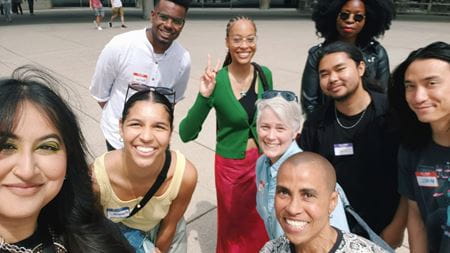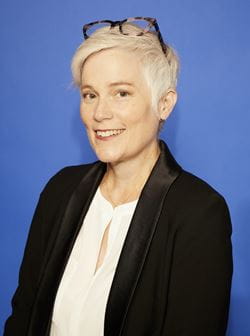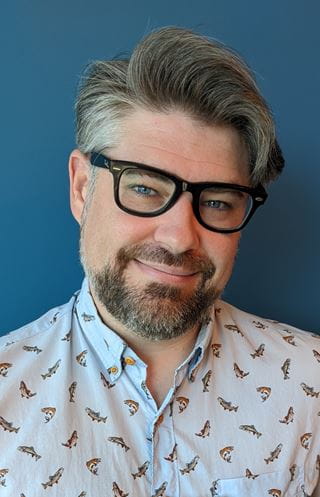
Sheridan instructor supports new generation of BIPOC photographers through mentorship program
 by Meagan Kashty – Aug 17, 2022
by Meagan Kashty – Aug 17, 2022  If you ask Heather Morton, there’s a key trait she’s observed in everyone she’s seen pursue a career in photography: a relentless sense of curiosity.
If you ask Heather Morton, there’s a key trait she’s observed in everyone she’s seen pursue a career in photography: a relentless sense of curiosity.
A professor in Sheridan’s Bachelor of Photography program for 11 years, Morton encourages her students to explore the world and find new ways of telling stories, using the camera as a medium. “I think the most successful photographers are curious by nature – they want to explore the world and express themselves and what they’re seeing in new, interesting ways.”
But in the summer of 2020, Morton had a lightbulb moment, realizing that there are serious barriers to entry for some aspiring photographers. She was chatting with Toronto photographer and long-time mentorship advocate May Truong, who mentioned that she had an overwhelming response of applicants when she unveiled a residency for emerging BIPOC/LGBTQ BIPOC photographers.
“There was clearly a tremendous need for these opportunities,” says Morton. “I became acutely aware of the need for mentorship programs for people who have traditionally been marginalized in the photography industry, and for whom the opportunity to even attend school or to access learnings in that space had been a bit of a premium.”
Morton also knew that she had access to a number of industry connections — connections who were looking to make a difference following the murder of George Floyd and the long overdue awakening on systemic racism.
In September 2020, Morton launched the BIPOC Photo Mentorship Program (BPM) — an initiative intended to address systemic barriers faced by emerging BIPOC photographers with the goal of encouraging diversity in the industry.
In those early days of the program, Morton’s approach was simple, driven by an Instagram feed and a call for mentors and mentees to add their contact info to a Google spreadsheet.
“It’s a phenomenon in the photography industry that you’re often very much working in your own silos. Mentorship is a strong way of helping provide an onramp.”
“It all came together pretty quickly,” Morton says. “The virtual communities being built as a result of the pandemic worked in the program’s favour. We encouraged our mentors to offer whatever time they had available, whether it be a virtual coffee chat every few months, or a weekly portfolio critique.”
BPM doesn’t pair up mentors and mentees. Instead, it works to facilitate the match by amplifying the offering. “One of the things I like about our program is that it isn’t structured and there’s no time limit to it,” explains Morton. “There’s also no barrier to participation. On both sides, we expect the mentor and the mentee to communicate their own expectations and then commit to the relationship and the mentorship agreement that they make with each other. BPM has a very basic structure with lots of individual agency on the part of both mentors and mentees to do the research, decide what works best for them, and to act on it.”
 Since that 2020 launch, the BPM has grown to over 370 members, including many Sheridan alumni. Mentees and mentors hail from around the world, including Africa, Europe and South America. The mentorships have varied in structure and content; from fielding business questions by phone, providing on-set opportunities, giving project-specific critique via Zoom and Facetime, offering structured research and shooting assignments, to hosting virtual group-based check-ins and encouragement.
Since that 2020 launch, the BPM has grown to over 370 members, including many Sheridan alumni. Mentees and mentors hail from around the world, including Africa, Europe and South America. The mentorships have varied in structure and content; from fielding business questions by phone, providing on-set opportunities, giving project-specific critique via Zoom and Facetime, offering structured research and shooting assignments, to hosting virtual group-based check-ins and encouragement.
The program has also gained national recognition. In Spring 2021, BPM was the recipient of an Ontario Arts Council grant in partnership with Gallery 44, enabling both organizations to provide monetary and matching support to selected mentees and mentors.
And in May 2022, in conjunction with Toronto’s Photo Laureate, Michèle Pearson Clarke, BPM unveiled Shine On – the inaugural exhibition of photographs produced by mentees in the BPM, aimed at reflecting the breadth of perspectives of the emerging generation of photographers. Presented on the grounds of Nathan Phillips Square as part of Doors Open Toronto, and curated by Toronto Photo Laureate Pearson Clarke, Shine On featured the work of 15 different GTA-based photographers, including five Sheridan alumni.
“This year’s theme of Open Doors Toronto, Renewal, was the perfect embodiment of the themes and ethos of BPM,” says Morton.
Going forward, Morton has plans that will see BPM continue to grow and evolve. And as the mentees continue to progress in their careers, she hopes they will return to the program as mentors to share their lived experiences.
“Hearing about the struggles and challenges from senior photographers not only helps aspiring photographers professionally – it can be therapeutic,” says Morton. “For our mentees, it can be so impactful to know that there’s somebody in their corner, gently pushing them forward. And our mentors have told me that they find it really stimulating and engaging to chat about the industry with younger people.”
“It’s a phenomenon in the photography industry that you’re often very much working in your own silos,” she adds. “Mentorship is a strong way of helping provide an onramp.”
Alumni testimonials
Sahar Rana (’20)
“I'm grateful for the mentorship program because of mentors who want the best for me. Their one-on- one guidance makes me feel like I'm not alone on this journey. Their support has led to opportunities I didn't expect and inspirational advice I'll be carrying with me onward, even in my personal life.”
Marc Santos (’19)
“The BIPOC Photo Mentorship Program has (been a wonderful) experience for me and inclusivity in a way I wasn’t expecting. Seeing this many people looking to help BIPOC youth in the photo industry excites me for what it will become for me and future artists.”
Pascal Lee (’19)
“The BIPOC mentorship has been a great way to address a big issue that plagues our industry and I'm happy to be a part of it. The program has also helped me find my strength not only as an artist, but most importantly as a minority, and that has been priceless.”
Jenisha Hibbert Thomas (’19)
“I just love that BIPOC creators are being given a space where we can learn and thrive in real work settings, which, at least for me, has carried on into building a network that is still helping me to this day.”
Craig Bagol (’19)
“I’m the only person in my family that’s chosen a creative/artistic career. In my case, that comes with a lack of understanding and emotional support, especially as someone who was previously on the route to be an engineer / Filipino golden child. The mentorship has been incredibly valuable to me because it's empowering and comforting knowing that I have someone in my corner to talk about work and life goals.”
Dominique Burnside (’21)
“This program allows upcoming creatives to learn from those who have spent many years in the professional industries and gain insight from the mentor’s personal journey. I believe this program is so important to the BIPOC community and allows us to continue to thrive in our respective crafts. With the continuation of a program like this, years of knowledge and guidance can continue to get passed on. There is so much to gain from perspective.”
Pictured top right: Heather poses with Toronto Photo Laureate Michèle Pearson Clarke and a few of the BIPOC Photo Mentorship Program mentees at Nathan Phillips Square.
Pictured bottom left: Heather Morton, photo by Steph Martyniuk
Media Contact
Meagan Kashty
Manager, Communications and Public Relations






